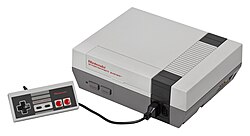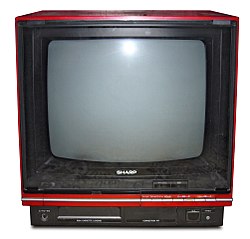Original variants
Family Computer

According to Uemura, video games were an unfamiliar concept to Japanese toy stores when they were introduced; the stores did not consider carrying them since they required televisions, which the stores did not sell at the time. Rather than targeting the educational market with PC-like styling, Uemura styled the Famicom like a toy as a cheaper option. [2] While Uemura's team intended to use an inexpensive steel case, they switched to a durable plastic due to the fragility of the steel case. [3] The red, gold, and white color scheme, chosen by Yamauchi, was inspired by two objects that used similar schemes: a scarf that he liked, and a set-top TV antenna from a company called DX Antenna. [3] [2]
Other design considerations took into account the lifestyles and attitudes of Japanese consumers at the time. Uemura had considered PC-like styling for the console, but elected to use a horizontally oriented design suited for placement on the floor; he felt Japanese consumers would prefer the latter as more relaxing. The controllers were designed to make the console's adoption among Japanese consumers easier; despite arriving on the market later than its competitors, the Game & Watch-inspired design provided a familiar control scheme for those who had already played one of its handheld electronic games, especially with the inclusion of a D-pad for versatility across game genres. They were also intentionally hardwired with short cables to keep players close to the console (and the TV by extension), ideal for Japanese houses due to their smaller layout compared to their American counterparts. [4]
Nintendo Entertainment System
Seeking to market the Famicom worldwide after its 1983 release in Japan, Nintendo forged a tentative distribution and rights agreement with Atari to market it outside the country as the Nintendo Enhanced Video System; however, both sides never consummated the deal as planned at the Summer CES in June 1983 due to a series of events that culminated in Atari collapsing amid the video game crash that year. [5] [6] Despite the pessimism of North American retailers, Yamauchi was still convinced that a launch there was feasible, so he ordered the introduction of a Famicom-based arcade system called the Nintendo VS. System the following year to gauge interest in the console's games there; the success of the system in North America encouraged Yamauchi to move forward with the launch. [7]
Under the direction of Lance Barr and Don James, the former of which then held the position of "Design & Brand Director" at Nintendo of America (NOA), the Famicom was initially redesigned to resemble a home computer; christened the Nintendo Advanced Video System (AVS), it featured peripherals such as a computer keyboard, a musical keyboard, a tape drive, infrared wireless controllers, and a folding light gun. [8] [9] The console itself featured a Famicom-like top-loading system and cartridges, whereas the controller's D-pad had a square shape similar to that of Sega's Master System. [10] The AVS was shown off at the Winter CES in January 1985, planned for a June release, to middling fanfare. [11] Chief among the concerns identified by Nintendo was the lingering stigma from the 1983 crash and the high price point the console was likely to command. [8]
After a cost-reduced revision of the AVS by Barr [12] was showcased at the Summer CES that June as the Nintendo Entertainment System (NES), Nintendo subsequently conceived a new design for the NES with colorations from Barr and James. [8] [13] Known among Nintendo employees as the "lunch box", the design—credited to engineer Masayuki Yukawa [14] —included a front-loading cartridge mechanism that was modeled after a videocassette recorder, mainly intended to further remove the console from the stigma of its contemporaries. [8] [12] Uemura later revealed in 2020 that the redesign was also intended to prevent a short circuit via direct contact with the hardware during cartridge insertion, which was especially problematic in a household full of static-inducing furniture in a semi-arid climate, as was the case in much of the Great Plains. [15]
While most of the peripherals that accompanied the AVS were scrapped, the light gun was kept, albeit in a cost-reduced form as the NES Zapper. To further dissuade consumers from perceiving the NES as a console, Nintendo introduced the Nintendo Video Robot, a toy robot that acted as a second player in two games; the presence of the robot, which was eventually named the Robotic Operating Buddy (R.O.B.) by advertising manager Gail Tilden, helped convince reluctant toy shops to place orders for the NES before it launched in New York City on October 18, 1985. [8]
PAL versions

Nintendo also marketed the NES in PAL regions through local distributors, though the console did not find as much success as it did in North America. In Europe, it was first released in Scandinavia in late 1986. [16] Nintendo then partnered with Mattel in 1987 to distribute the NES in the United Kingdom and Italy; the same year, the console was introduced to France, Belgium, the Netherlands, and Luxembourg via Nintendo Entertainment Systems International (NESI), a French private company led by former NOA salesperson Ron Judy. [16] [17] However, Mattel's lackluster marketing effort in the face of strong competition from the home computer market led Nintendo to give the British distribution rights to NESI the following year. [16] NESI handed over its distribution rights to Bandai in 1992 before Nintendo reclaimed them in 1995. [16] [17] Other parts of the European market were not given as much attention, with the NES making its debut in Hungary, for example, in 1991 via the Austrian distributor. [16]
In Oceania, Mattel gained the distribution rights for Australia and New Zealand, with both receiving the NES in mid-1987. While the console fared better in those countries compared to Europe, it did not gain significant traction until c. 1993. [16] [18] The same year, Nintendo established a regional subsidiary—Nintendo Australia—and subsequently reclaimed the distribution rights the following year. [18] [19]
Europe was split into two zones for distribution; the United Kingdom and Italy were designated as PAL-A, while the rest of Europe was designated as PAL-B. Consoles from one zone are not compatible with games from the other zone. [20] Also, unique to the French NES consoles is the inclusion of an audiovisual (AV) port that outputs RGB video via a SCART connector instead of composite; however, since the NES is not capable of RGB output (in its original form), it converts the native composite signal to RGB. [20] [21]
Asian versions
The NES was also released in other regions of Asia outside Japan (except for mainland China). [22] In particular, South Korea received the NES via distributor Hyundai Electronics as the Hyundai Comboy in October 1989. [23] Nintendo could not sell the NES directly in the country as Japanese cultural imports were banned by the government at the time, dating back to the end of World War II; the ban stayed in effect until 2004. [24] In India, a license-built version of the PAL-region NES was sold as the Samurai Electronic TV Game System. [25] However, due to the prohibitively expensive price of the console, it sold poorly in the country; the Samurai brand was later reused on a series of unauthorised Famiclone consoles. [26]









